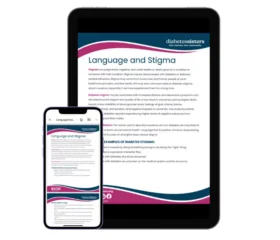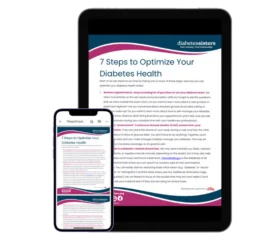Be Heart Smart and have FUN doing it!

As a person with diabetes, you may already know that:
- Heart disease is the leading cause of death in women in the U.S. (1)
- About one in 16 white, Black, and Hispanic women and about one in 30 Asian women, age 20 and older, have coronary heart disease, the most common type of heart disease. (2)
- Women who have diabetes are three to four times more likely to develop heart disease than women without diabetes. (3)
- Women with diabetes often get heart disease in their 40s and 50s, and women with diabetes are more likely to have fatal heart attacks than men with diabetes. (4)
But here is some good news – as a woman, there are many easy and enjoyable things you can do to protect your heart! So let’s get started!
Heart smarts are all about living a fun, healthy lifestyle:
- Have fun getting more active! Do activities you enjoy or love, like walking in a park, dancing, bicycling, swimming, or yoga. When you enjoy an activity, it’s fun, not a “chore” and you are much more likely to stick with it as a fun daily habit.
- If you smoke, quit! You’ll look and feel better, and save money. Women who smoke are at higher risk for a heart attack than men. Many employers provide health coaches to help you quit smoking, and there are many free online resources to help you quit. (5)
- Aim for a healthy waist size, not a target weight! Too many women (and men) make the mistake of dieting to lose “X” number of pounds. The problem is if you lose muscle along with fat, which nearly everyone on a diet dies, your joints weaken, and you’re more likely to injure yourself.
A better measurement of health is to get a waist size of less than half your height. If you are 5’ 6” tall (66”), then you want a waist size that is less than half that, so 32” or less is a good waist size goal.
If you do some weight lifting, yoga, or pilates that tones your body, your weight might go down, stay the same, or go up, but if your waist size is going down, that means you are losing fat and gaining healthy lean muscle. Congratulations! More lean muscle and less body fat tend to keep your blood sugar in your target range even when you are just sitting. Ignore that scale! - Enjoy healthy meals! Typically, what are healthy meals? Healthy meals should be based on what mom told us “Eat LOTS of low-carb vegetables, some fruit, lean protein (especially from cooked dried beans and other legumes), some whole grains, and small amounts of a wide variety of nuts and seeds.
- Enjoy good mental health. Everyone has stress in their life, but you can choose HOW you react to stress. Always take time for yourself every day to let go of stress. Go for a brisk walk, listen to your favorite relaxing music, read inspiring stories, meditate, close your eyes and focus on the sound of your breath, or take a warm, soothing bubble bath. There are many enjoyable, easy and free ways to lower stress.
- If you suffer from depression, get professional help. Mental health is like growing a garden: you need healthy soil (healthy eating), sunshine (fun and activity), water (hydration, rest, and sleep), and to get rid of the weeds (stress and depression) to keep your mental health ‘garden’ blooming. Don’t hesitate to reach out for support from your friends and family because stress and depression are more likely to harm women’s hearts than men’s hearts. (6)
- Manage your ABCss:
A: Get a regular A1C test to measure your average blood sugar over 2 to 3 months, and aim to stay in your target range as much as possible.
B: Try to keep your Blood pressure below 140/90 mm Hg (or the target your doctor sets).
C: Manage your Cholesterol levels.
s: Stop Smoking or don’t start.
s: Keep the Sodium and Salt content of foods low - Limit the amount of alcohol you drink. Too much alcohol can increase your risk of high blood pressure, stroke, and heart failure. Find a green tea or herbal tea you like and drink lots of it. Have water with a wedge of lemon, lime, or orange as a delicious alternative drink.
- Keep the salt and sodium content of foods low. Eating unprocessed or minimally processed whole foods automatically keeps your sodium intake low. Instead of shaking on salt, use herbs and spices to add lots of flavor to foods without the sodium that can cause high blood pressure and heart problems.
- Monitor your blood sugar numbers. Keeping your blood sugar and A1C in your target range isn’t always easy, but with a healthy lifestyle and mindset, it may be easier!
If you are having difficulties or challenges you can’t overcome, talk with your doctor or healthcare provider for guidance and help.
If you experience any heart attack symptoms, feel more tired than usual, aren’t sleeping well, have anxiety, or have a racing heart, don’t hesitate to let your doctor know or get medical attention immediately.
Last but not least, take your medicines as prescribed. Medications may help you get and keep your numbers at goal and help manage physical and emotional symptoms. It’s always a good idea to review all of the medicines that you take with your doctor, as you might be able to reduce the amount or change what you are taking.
References and Resources
Centers for Disease Control and Prevention https://www.cdc.gov/diabetes/library/features/diabetes-and-heart.html
1 https://www.ncbi.nlm.nih.gov/pmc/articles/PMC6179634
2 https://www.cdc.gov/heartdisease/women.htm
3 https://pubmed.ncbi.nlm.nih.gov/22945305
4 https://www.heart.org/en/news/2019/05/14/why-are-women-with-diabetes-at-greater-risk-for-poor-heart-health
5 https://www.cdc.gov/tobacco/campaign/tips/quit-smoking/index.html
6 https://www.ncbi.nlm.nih.gov/pmc/articles/PMC5290226
Tom Lang has worked as a research assistant at the pharmaceutical giant Hoechst in Germany and at The Albert Einstein College of Medicine in New York. Trained as a biologist, he lives on the west coast with his wife, Cate, and their rescued dog, Te amo. Tom has coached over 1,000 women and men with prediabetes and diabetes and has helped two family members with diabetes.
Written by





